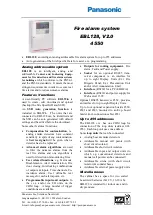
Page 2
ALARM TECHNOLOGY & FEATURES
This is a 3-in-1 combination smoke + fire + carbon monoxide (CO) alarm. The 10 year lithium-free
sealed battery provides continuous protection even in the event of a power outage.
• There are three basic smoke alarm types: UNIVERSAL
®
Sensing Plus
®
, Ionization and
Photoelectric
• UNIVERSAL
®
Sensing Plus
®
uses the Advanced Intelligence of Multi-Criteria Technology and a
Patented Microprocessor to respond quickly to both fast flaming fires and slow smoldering fires.
• Ionization smoke alarms are typically more effective at detecting fast flaming fires—fires which
consume combustible materials rapidly and spread quickly. Sources of these fires may include
paper burning in a wastebasket, or kitchen grease fires.
• Photoelectric smoke alarms, on the other hand, are typically more effective at detecting slow
smoldering fires—fires which burn for hours before bursting into flame. Sources of these fires
may include cigarettes burning in couches or bedding.
• Installing alarms containing UNIVERSAL
®
Sensing Plus
®
technology ensures maximum
detection of all types of fires.
The enclosed alarm is a 3-in-1 Carbon Mo
UNIVERSAL
®
Sensing Plus
®
Smoke + Fire Smart Alarm.
KEY PRODUCT FEATURES
Smart Alarm Technology
virtually eliminates nuisance alarms caused by non-hazardous sources
such as every day cooking smoke and steam
Permanent Power
battery provides continuous protection and eliminates low battery chirps.
Never replace batteries.
Lithium Free 10 Year Sealed Power Supply
features Duracell
®
Duralock Power Preserve™
Technology alkaline batteries providing a safer, greener alternative
This alarm meets the new UL217 8th Edition requirements for the detection of polyure-
thane foam in both slow smoldering & fast flaming fires; resistance to false alarms from
cooking; and it passes the tests for immunity to high-voltage current surges.
ALARM LIMITATIONS AND FUNCTIONS
• IMPORTANT: ALARMS WILL NOT WORK WITHOUT POWER.
Therefore, installing an alarm
with a sealed battery or an alarm powered from two different power sources can give an extra
measure of protection. A hardwired alarm with backup battery power will provide protection in
the event of an AC power failure. Battery operated alarms cannot work if the batteries are
missing, disconnected or dead. If you are concerned about the limitations of the battery or
AC power, install both types of alarms.
• PROPERLY LOCATE THE ALARM TO AVOID NUISANCE ALARMS.
Using an ionization
smoke alarm without
UNIVERSAL
®
Sensing Plus
®
in a smokey area, such as a kitchen, or in a
high humidity area near a shower, can cause nuisance/false alarms.
• DO NOT DEACTIVATE THE BATTERY TO QUIET A NUISANCE/FALSE ALARM.
The alarm
will not provide protection if it is not receiving power. Properly locate the alarm to avoid
nuisance/false alarms.
• SMOKE, CO OR GAS ALARMS MAY NOT ALWAYS WARN ABOUT DANGERS CAUSED BY
CARELESSNESS.
Safety hazards such as smoking in bed, violent explosions, escaping gas,
improper storage of flammable materials, overloaded electrical circuits, children playing with
matches, natural causes such as lightning and arson. Prevention and appliance maintenance is
the best safeguard.
• INSTALLING ALARMS MAY MAKE YOU ELIGIBLE FOR LOWER INSURANCE RATES,
BUT ALARMS ARE NOT A SUBSTITUTE FOR INSURANCE.
Home-owners and renters alike
should continue to insure their lives and properties.
• SMOKE ALARMS CANNOT DETECT FIRES IF THE SMOKE DOES NOT REACH THEM.
Smoke from fires may not reach the sensing chamber and set off the alarm. Do not obstruct
airflow around the smoke alarm or place in areas of obstructed airflow.
• SMOKE ALARMS MAY NOT BE EFFECTIVE IN VARIOUS AREAS.
For example: (1) Fires
where the victim is intimate with fire due to a person’s clothes catching fire while cooking; (2)
Fires where the smoke is prevented from reaching the alarm due to a closed door or other
obstruction; (3) Incendiary fires where the fire grows so rapidly that an occupant’s egress is
blocked even with properly located alarms.

































